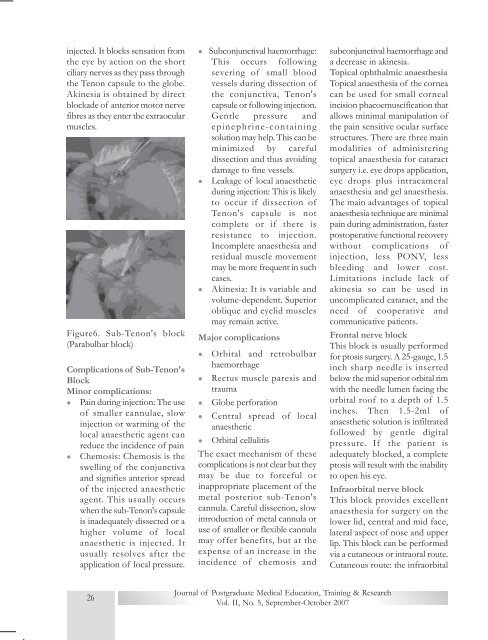National Board Ex- 6 Book .pmd - National Board Of Examination
National Board Ex- 6 Book .pmd - National Board Of Examination
National Board Ex- 6 Book .pmd - National Board Of Examination
Create successful ePaper yourself
Turn your PDF publications into a flip-book with our unique Google optimized e-Paper software.
injected. It blocks sensation fromthe eye by action on the shortciliary nerves as they pass throughthe Tenon capsule to the globe.Akinesia is obtained by directblockade of anterior motor nervefibres as they enter the extraocularmuscles.Figure6. Sub-Tenon's block(Parabulbar block)Complications of Sub-Tenon'sBlockMinor complications:l Pain during injection: The useof smaller cannulae, slowinjection or warming of thelocal anaesthetic agent canreduce the incidence of painl Chemosis: Chemosis is theswelling of the conjunctivaand signifies anterior spreadof the injected anaestheticagent. This usually occurswhen the sub-Tenon's capsuleis inadequately dissected or ahigher volume of localanaesthetic is injected. Itusually resolves after theapplication of local pressure.l Subconjunctival haemorrhage:This occurs followingsevering of small bloodvessels during dissection ofthe conjunctiva, Tenon'scapsule or following injection.Gentle pressure andepinephrine-containingsolution may help. This can beminimized by carefuldissection and thus avoidingdamage to fine vessels.l Leakage of local anaestheticduring injection: This is likelyto occur if dissection ofTenon's capsule is notcomplete or if there isresistance to injection.Incomplete anaesthesia andresidual muscle movementmay be more frequent in suchcases.l Akinesia: It is variable andvolume-dependent. Superioroblique and eyelid musclesmay remain active.Major complicationsl Orbital and retrobulbarhaemorrhagel Rectus muscle paresis andtraumal Globe perforationl Central spread of localanaestheticl Orbital cellulitisThe exact mechanism of thesecomplications is not clear but theymay be due to forceful orinappropriate placement of themetal posterior sub-Tenon'scannula. Careful dissection, slowintroduction of metal cannula oruse of smaller or flexible cannulamay offer benefits, but at theexpense of an increase in theincidence of chemosis andsubconjunctival haemorrhage anda decrease in akinesia.Topical ophthalmic anaesthesiaTopical anaesthesia of the corneacan be used for small cornealincision phacoemuscification thatallows minimal manipulation ofthe pain sensitive ocular surfacestructures. There are three mainmodalities of administeringtopical anaesthesia for cataractsurgery i.e. eye drops application,eye drops plus intracameralanaesthesia and gel anaesthesia.The main advantages of topicalanaesthesia technique are minimalpain during administration, fasterpostoperative functional recoverywithout complications ofinjection, less PONV, lessbleeding and lower cost.Limitations include lack ofakinesia so can be used inuncomplicated cataract, and theneed of cooperative andcommunicative patients.Frontal nerve blockThis block is usually performedfor ptosis surgery. A 25-gauge, 1.5inch sharp needle is insertedbelow the mid superior orbital rimwith the needle lumen facing theorbital roof to a depth of 1.5inches. Then 1.5-2ml ofanaesthetic solution is infiltratedfollowed by gentle digitalpressure. If the patient isadequately blocked, a completeptosis will result with the inabilityto open his eye.Infraorbital nerve blockThis block provides excellentanaesthesia for surgery on thelower lid, central and mid face,lateral aspect of nose and upperlip. This block can be performedvia a cutaneous or intraoral route.Cutaneous route: the infraorbital26Journal of Postgraduate Medical Education, Training & ResearchVol. II, No. 5, September-October 2007
















